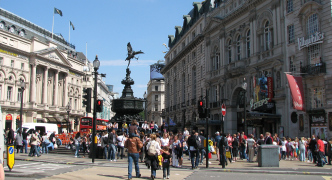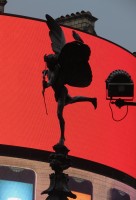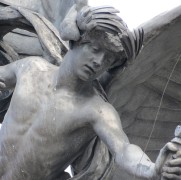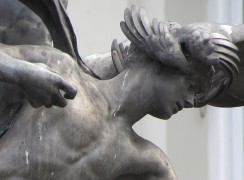
In a pantheon of iconic London statues, the Statue of Eros would certainly be among the top three, much photographed by visitors to London and featuring on the masthead of the Evening Standard, the main evening weekday free paper in the city. It was put up in 1893 as the Shaftesbury Memorial Fountain, and the sculptor was Alfred Gilbert.
Here are several pictures of the Eros statue from different aspects. He is depicted as a youth, firing his arrow downwards, leading various romantic stories to grow up about people who place themselves in the line of fire. Eros is nude, with a swirl of drapery around him to protect the sensibilities of the late Victorian pedestrian. His pose, on one leg, and tilted forward, somewhat recalls various statues of Mercury, ultimately tracing back to that by Giovanni di Bologna in Florence, which dates from the late 16th Century - there are several derivative figures in England, for example in Liverpool and Doncaster. But the Eros leans further over, and his limbs, wing and head form a star-shape when seen from where the body, but not the headd, faces the viewer. Indeed part of the charm of the figure is the outline from various aspects.
Different views of the statue of Eros.
If we visit the statue at twilight, it forms a dramatic silhouette in front of the bank of advertising lighting on the building behind, as shown here. Like other works by Alfred Gilbert, the figure in a rather Art Nouveau idiom, sensitively modelled and with a nobility of face. Gilbert was of course a central figure in the New Sculpture movement of largely-French trained British artists who favoured a naturalism, and in the male figures, a slightness of form and athletic but rather slender rather than heroic musculature. Gilbert revelled in jewel-like decorative details to his works, as shown in the close-up here, showing the delicate wings of Eros's helm, and of course in the variety of creatures on the fountain base.
 Eros with Coco Cola advert backdrop.
Eros with Coco Cola advert backdrop.
The base is made of bronze, but the figure of Eros, unusually, is made of Aluminium, then a costly and almost precious metal. This has been a problem in that over the years, people climbing on the monument have tended to damage the ankle, but the light weight did mean that the support could be rather thinner than would have been necessary to support the weight of a bronze figure.

 Detail of the head and upper body.
Detail of the head and upper body.
The Shaftesbury Memorial Committee originally asked J. E. Boehm to be the sculptor, and was only Gilbert's commission after Boehm turned it down. Having persuaded the Committee to have an ideal work rather than a statue of the subject, great delay was caused when at one point the Committee demanded that the final memorial at least include a portrait bust, only backing down when this was shown to look inappropriate as part of the otherwise purely imaginative sculpture. Partly as a result of this, and partly due to changing metal prices, Gilbert spent more on producing the work than the payment he received. It marked rather a turning point for the sculptor, as he developed a habit of taking on more commissions than he could realistically complete, and not costing his work properly, so that in the end, in 1901 he became bankrupt. However, towards the end of his life, he was able to resume his career on a more financially sound basis, being knighted a couple of years before his death in 1934.
A little more information is on the Piccadilly Circus page.
This page was originally part of a 'sculpture of the month' series, for May 2013. Although the older pages in that series have been absorbed within the site, if you would wish to follow the original monthly series, then jump to the next month (June 2013) or the previous month (April 2013). To continue, go to the bottom of each page where a paragraph like this one allows you to continue to follow the monthly links.
Leicester Square // North and West into Regent Street // South along Lower Regent Street to Waterloo Place // South-East to Trafalgar Square
Sculpture walk along Piccadilly
Visits to this page from 1 May 2013: 15,056